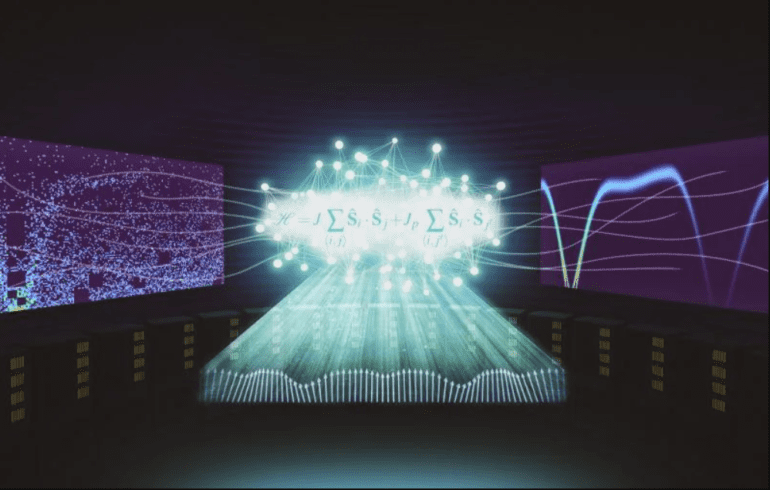TL;DR:
- Researchers at SLAC National Accelerator Laboratory leverage machine learning to decode complex material behaviors.
- A new data-driven tool utilizing neural implicit representations, automates parameter derivation from experimental data.
- Collective excitations in materials, critical for advanced technologies like spintronics, are studied using machine learning.
- Machine learning surpasses traditional methods in data interpretation, guiding experiments in real-time.
- The ‘coordinate network’ model holds potential for diverse scattering measurements.
- Continuous real-time analysis empowers researchers to conclude experiments efficiently.
Main AI News:
The Department of Energy’s SLAC National Accelerator Laboratory has embarked on a groundbreaking journey to unravel the intricate behaviors of materials, employing the capabilities of machine learning to decode coherent excitations. These excitations encompass the synchronized oscillation of atomic spins within a given system—a phenomenon that has long eluded comprehensive understanding.
Recently published in the prestigious pages of Nature Communications, this pioneering research promises to usher in a new era of efficiency in experimental procedures, offering real-time guidance to scientists during data collection. Spearheaded by Howard University, with collaborative efforts from researchers at SLAC and Northeastern University, this DOE-funded initiative harnesses the formidable potential of machine learning to accelerate materials research.
The bedrock of this endeavor is a novel data-driven tool crafted using “neural implicit representations.” This ingenious development, already prevalent in fields such as computer vision, medical imaging, particle physics, and cryo-electron microscopy, has now found its way into materials science. What sets this tool apart is its remarkable capacity to swiftly and accurately derive previously unknown parameters from experimental data, automating a process that had hitherto demanded extensive human intervention.
Unraveling the Enigma of Collective Excitations
The heart of this scientific endeavor lies in unraveling the mysteries of collective excitations, a phenomenon crucial to deciphering the behavior of complex systems, particularly magnetic materials with multifaceted components. At the microscopic level, certain materials exhibit peculiar behaviors, characterized by subtle variations in the patterns of atomic spins. These properties hold immense promise for emerging technologies, such as advanced spintronics devices poised to revolutionize data transfer and storage.
To explore these collective excitations, scientists have traditionally relied on techniques like inelastic neutron or X-ray scattering. However, these methods, while informative, pose challenges owing to their intricacy and resource-intensive nature, including the limited availability of neutron sources.
Machine Learning: A Quantum Leap Forward
Machine learning emerges as the beacon of hope in overcoming these challenges, albeit with its own set of limitations. Past efforts have seen machine learning techniques enhance the accuracy of X-ray and neutron scattering data interpretation, predominantly based on conventional image-based data representations. However, the team at SLAC adopts a different trajectory with their novel approach, leveraging neural implicit representations.
These representations employ coordinates akin to points on a map as inputs. In image processing, these neural networks can predict the color of a specific pixel based on its position. Instead of storing the image directly, they generate a recipe for interpretation, connecting pixel coordinates to their corresponding colors. This enables them to make intricate predictions, even in the spaces between pixels. Such models have demonstrated remarkable efficacy in capturing intricate details in images and scenes, making them a promising asset for deciphering quantum materials data.
Alexander Petschm, a postdoctoral research associate at SLAC’s Linac Coherent Light Source (LCLS) and Stanford Institute for Materials and Energy Sciences (SIMES), elucidates, “Our motivation was to understand the underlying physics of the sample we were studying. While neutron scattering can provide invaluable insights, it requires sifting through massive data sets, of which only a fraction is pertinent.”
Deciphering Nuances with Machine Learning
The team embarked on a mission to measure at LCLS, feeding the data into a machine learning algorithm, with the aim of unveiling microscopic material details in real-time. Thousands of simulations were conducted, exploring a myriad of parameters, all contributing to the algorithm’s ability to extrapolate theoretical answers from actual spectra measurements.
A serendipitous revelation occurred when measurements closely resembled inelastic neutron scattering data, an alignment noticed by Alexander Petschm. When their machine learning model was applied to this real-world data, it triumphed over challenges like noise and missing data points.
Revolutionizing Experimental Procedures
Traditionally, researchers have relied on intuition, simulations, and post-experiment analysis to guide their research trajectory. The team’s innovative approach, however, offers a paradigm shift by enabling continuous real-time data analysis. This represents a profound shift in the research landscape, as it empowers researchers to discern precisely when they have accumulated sufficient data to conclude an experiment, thus streamlining the entire process.
Josh Turner, a scientist at SLAC overseeing the research, highlights the transformative potential of their machine learning model: “Our machine learning model, trained before the experiment even begins, can rapidly guide the experimental process. It could change the way experiments are conducted at facilities like LCLS.”
A Versatile Tool for Advancement
The ‘coordinate network,’ the core of this model’s design, is not confined to neutron scattering alone. Its adaptability extends across a spectrum of scattering measurements, where data is a function of energy and momentum.
As Sathya Chitturi, a PhD student at Stanford University and a co-author, aptly puts it, “Machine learning and artificial intelligence are influencing many different areas of science. Applying new cutting-edge machine learning methods to physics research can enable us to make faster advancements and streamline experiments. It’s exciting to consider what we can tackle next based on these foundations. It opens up many new potential avenues of research.”
Conclusion:
The fusion of machine learning and materials science at SLAC National Accelerator Laboratory has birthed a remarkable innovation. This AI-driven tool, with its neural implicit representations and real-time analysis capabilities, holds the promise of revolutionizing experimental procedures, ushering in an era of efficiency and precision in the quest to understand and manipulate the behavior of materials at the quantum level. The implications extend far beyond materials science, offering a glimpse into a future where machine learning accelerates progress across diverse scientific domains.

